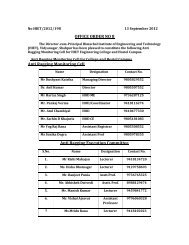Download Syllabus of Mechanical Engineeing. - HIET
Download Syllabus of Mechanical Engineeing. - HIET
Download Syllabus of Mechanical Engineeing. - HIET
Create successful ePaper yourself
Turn your PDF publications into a flip-book with our unique Google optimized e-Paper software.
D:\MAM\Proposed Schema for Mech Engg\<strong>Syllabus</strong> <strong>of</strong> <strong>Mechanical</strong> for III sem.doc<br />
SEMESTER – III<br />
FLUID MECHANICS ME – 3005<br />
Course Code ME – 3005 Credits : 5 L-4, T-1, P-0<br />
Name <strong>of</strong> the Course Fluid Mechanics<br />
Lectures to be delivered 65 (1 Hr Each) (L = 52, T = 13 for each semester)<br />
Semester End Max. Time = 3 hrs. Max. Marks: 100 Min. Pass Marks: 40<br />
Examination<br />
Continuous Assessment (based on sessional<br />
tests (2) 50%, Tutorials/Assignments 30%,<br />
Quiz/Seminar 10%, Attendance 10%)<br />
Instructions<br />
Max. Marks: 50<br />
1. For Paper Setters: The question paper will consist <strong>of</strong> five sections A, B, C,<br />
D & E. Section E will be compulsory, it will consist <strong>of</strong> a single question with<br />
10-20 subparts <strong>of</strong> short answer type, which will cover the entire syllabus and<br />
will carry 40% <strong>of</strong> the total marks <strong>of</strong> the semester end examination for the<br />
course. Section A, B, C & D will have two questions from the respective<br />
sections <strong>of</strong> the syllabus and each question will carry 15% <strong>of</strong> the total marks<br />
<strong>of</strong> the semester end examination for the course.<br />
2. For candidates: Candidates are required to attempt five questions in all<br />
selecting one question from each <strong>of</strong> the sections A, B, C & D <strong>of</strong> the question<br />
paper and all the subparts <strong>of</strong> the questions in Section E. Use <strong>of</strong> nonprogrammable<br />
calculators is allowed.<br />
SECTION – A<br />
Introduction<br />
Fluid and flow-definition and types, properties <strong>of</strong> ideal and real fluids, continuum<br />
concept, Lagrangian & Eulerian approach.<br />
Fluid Statics<br />
General differential equation, manometry, Force on plane and curved surfaces,<br />
stability <strong>of</strong> floating and submerged bodies, Relative equilibrium.<br />
SECTION – B<br />
Kinematics <strong>of</strong> fluid<br />
Steady flow, uniform flow, stream, streak and path lines, continuity equation, stream<br />
function, irrotational flow, velocity potential, flow nets, circulation, simple flows, flow<br />
around circular cylinder with and without rotation, lift and drag.<br />
1



